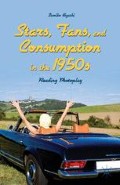Abstract
An enchanting child star who became the world’s most beautiful woman while she was still in her teens, Elizabeth Taylor was a sensational femme fatale who inspired voluminous publicity stories. Decidedly not the congenial girl next door, she was a prima donna whose shopping sprees and sex scandals invited readers to fantasize on a baroque scale. Compared to wholesome Debbie Reynolds, she represented uncommon entitlement that was far beyond the reach of ordinary fans, if not their dreams. She led an extravagant life that intensified magazine reading as fantasy, escapism, sensationalism, voyeurism, and scandalmongering.1 With prescience, Elsa Maxwell wrote in a Photoplay cover story titled “The Most Exciting Girl in Hollywood” that the star was destined “to live in the tradition of great beauties who lived lives more colorful and romantic and exciting than any role they ever essayed on screen or on stage.” She was indeed. Always intemperate, Taylor remains most compelling as a print media personality. Certainly, her melodramatic love affairs, eating and drinking binges, haute couture gowns, Bulgari gems, and incessant travel personified the surfeit of modern consumption. Unlike Maxwell, Louella Parsons was more speculative about the young star: “Only time will tell what she eventually will be, a settled miss,… or one of the really great glamour girls.” But an intriguing narrative arc based on gossip and rumor was evident from the beginning of her involvement with men.
Access this chapter
Tax calculation will be finalised at checkout
Purchases are for personal use only
Preview
Unable to display preview. Download preview PDF.
Notes
On the star, see Camille Paglia, Sex, Art, and American Culture: Essays (New York: Viking, 1992); Aida A. Hozic, “Hollywood Goes on Sale; or, What Do the Violet Eyes of Elizabeth Taylor Have to Do with the Cinema of Attractions?” in Hollywood Goes Shopping, eds. David Desser and Garth S. Jowett (Minneapolis: University of Minnesota Press, 2000), 205–22l; Suzanne Leonard, “The ‘True Love’ of Elizabeth Taylor and Richard Burton,” in Reclaiming the Archive: Feminism and Film History, ed. Vicki Callahan (Detroit: Wayne State University Press, 2010), 74–97; M. G. Lord, The Accidental Feminist: How Elizabeth Taylor Raised Our Consciousness and We Were Too Distracted by Her Beauty to Notice (New York: Walker, 2012); Gaylyn Studlar, Precocious Charms: Stars Performing Girlhood in Classical Hollywood Cinema (Berkeley: University of California Press, 2013), chap. 4.
Ann MacGregor, “Love and a Girl Named Liz,” Photoplay (June 1949): 36; Elsa Maxwell, “The Most Exciting Girl in Hollywood,” Photoplay (January 1949): 56, 83–84; Louella O. Parsons, “Sub-deb or Siren?” Photoplay (March 1950): 46, 76; Ida Zeitlin, “Liz Spoiled Brat or Mixed-Up Teenager,” Photoplay (May 1951): 40, 95–97.
Louella O. Parsons, “Elizabeth’s Love Story,” Photoplay (June 1950): 38, 104–105; Ads for Tangee, Lovalon, Photoplay (June 1950): 104–105; Elsa Maxwell, “Honeymoon Unlimited,” Photoplay (October 1950): 34, 40, 43, 87–88; Louella O. Parsons, “Liz and Nick Speak for Themselves,” Photoplay (January 1951): 78; Ad for Lux, Photoplay (June 1950): 32; Elsa Maxwell, “The Breaking Point,” Photoplay (April 1951): 37, 96–97; Zeitlin, “Spoiled Brat,” 95–97.
Colin Campbell, The Romantic Ethic and the Spirit of Modern Consumerism, 3rd ed. (London: Alcuin Academics, 2005), 87.
Sidney Skolsky, “Photoplay Goes to the Wedding,” Photoplay (August 1959): 26, 84–86; Ads for My True Story, “Loneliness,” sweetener, Photoplay (December 1958): 72–73, 75; Ad for Santa Fe, Photoplay (May 1959): 81.
See Sumiko Higashi, “Stardom, Intermarriage, and Consumption in the 1950s: The Debbie–Eddie–Liz Scandal” in Hollywood’s Chosen People: The Jewish Experience in American Cinema, eds. Daniel Bernardi, Murray Pomerance, and Hava Tirosh-Samuelson (Detroit: Wayne State University Press, 2013). Copyright (c) 2013. Used with permission of the publisher.
Gerry Gordon, “Eddie Exposes Liz and We Have His Story,” Photoplay (July 1962): 82–84; Jae Lyle, “The Other Woman in Eddie’s Life,” Photoplay (May 1962): 77; Sidney Skolsky, “Mr. & Mrs. Burton’s Strange Marriage Deal,” Photoplay (July 1962): 46, 74–76; Jim Hoffman, “We Know! Does Liz? What Ann-Margret Gives That Even Liz Can’t!” Photoplay (January 1963): 43, 67; Jim Hoffman, “Blackmail,” Photoplay (January 1962): 36; Hopper, “Passion and Waste,” 81–83; Aljean Meltsir, “Liz’ Love Deal with the Burtons,” Photoplay (February 1963): 49.
Jae Richards, “Liz and Burton Shameless Lovers,” Photoplay (October 1962): 38–43, 90; Dick Davis, “Liz Loses Burton,” Photoplay (December 1962): 87; Hoffman, “Terrible Truth,” 39, 84–86; Jim Hoffman, “Wedding Bells Toll Liz & Burton’s Doom,” Photoplay (November 1962): 97; Oates, “Liz Humiliated Eddie,” 91; Jeff Cronin, “The 4-Letter Word that Rules Liz’ Life,” Photoplay (October 1963): 85; Leslie Valentine, “6 Clergymen Reveal How Liz Can Be Saved,” Photoplay (June 1963): 89–90; Skolsky, “Strange Marriage Deal,” 76; Ad for Dolls, Photoplay (August 1962): 86; Ads for Abdo-Slim and Gravy Boat, Photoplay (November 1962): 87.
Copyright information
© 2014 Sumiko Higashi
About this chapter
Cite this chapter
Higashi, S. (2014). Elizabeth Taylor. In: Stars, Fans, and Consumption in the 1950s. Palgrave Macmillan, New York. https://doi.org/10.1057/9781137431899_11
Download citation
DOI: https://doi.org/10.1057/9781137431899_11
Publisher Name: Palgrave Macmillan, New York
Print ISBN: 978-1-349-49284-8
Online ISBN: 978-1-137-43189-9
eBook Packages: Palgrave Media & Culture CollectionLiterature, Cultural and Media Studies (R0)

